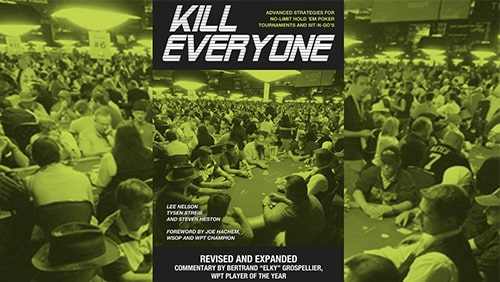From strategy bibles to autobiographies, each week we open the pages of a poker book that we either love, like or hate. We let you know about it and you, in turn decide if you add it to your collection.
 Over the last few months, we’ve covered the opinions of World Series of Poker bracelet winners, poker coaches, celebrities and hopefuls all of whom are pursuing goals and often accentuating the positive.
Over the last few months, we’ve covered the opinions of World Series of Poker bracelet winners, poker coaches, celebrities and hopefuls all of whom are pursuing goals and often accentuating the positive.
This week’s book has a slightly different title.
Kill Everyone was released four years after the Moneymaker moment, in 2007. Smack bang in the middle of a poker boom that had enveloped much of the Western world, the book was written by Lee Nelson, Tysen Streib and Kim Lee, with contributions from Bertrand ‘ElkY’ Grospellier and focal points on players like Phil Ivey.
The first thing to say about Kill Everyone is that this book is not for the poker newbie. It’s aimed at moderate to advanced players, so if you’re just starting out in poker, it’s probably best to bookmark this review and look at other options more focused on improving the recreational player to becoming profitable.
If you’ve already established yourself as a winner player, however, then this book will likely be invaluable in maintaining your edge over your opponents at both the online and live felt. There are a large number of ways that Kill Everyone tries to help your poker game, from introducing new concepts (new for 2007, remember), making your poker maths knowledge more solid and setting up advanced strategies for surviving large-field MTTs (multi-table tournaments), Sit ‘n’ Go’s and satellite games.
The original version focused on these strategies and walked you through them without professional commentary along the way, but the revised and expanded second edition is the version of the book we’d recommend, with the annotations from Bertrand ‘ElkY’ Grospellier adding a lot to the tome, with 50 pages of his thoughts scattered throughout the book.
A lot of poker game theory in the modern game focuses on what you should be doing, but while Kill Everyone covers a lot of the strategies you’ll want to implement in your own game, there is a lot of emphasis on reacting to your opponents and how to interrupt their own comfort at the table.
A lot of the ‘survival’ parts of a poker tournament, such as being short-stacked, approaching the money bubble or getting near the final table are approached really well. There are helpful theories, backed up by the mathematics of any situation, and coupled with poker models courtesy of Tysen Streib, the book offers a lot to players who want to smooth over the edges in their own game.
Kill Everyone can rightly claim to improve you not only as a poker player, but as a reactive poker player, too. After reading, we felt there was less anxiety about worrying areas of the game, pressure points were eased and confidence had a chance to grow.
With an introduction by 2005 WSOP Main Event winner Joe Hachem, Kill Everyone is a book that everyone who plays poker to a decent level will benefit from owning. With a new chapter in the second edition on short-handed cash games – which can play a lot like tournament play in some ways – there is something for everyone who loves tournaments.
If you’re looking for a book to help you beat the micro-stakes, you’re not going to benefit too much from buying Kill Everyone. However, if you’re running a profit and want some great techniques to improve your game, this might very well be the best book you can buy to do so. There are insightful looks at Phil Ivey’s game that very few have gone near covering before and they are some of the most entertaining sections in the book.
We’ll revisit Lee Nelson’s work in future weeks, with a look at The Raiser’s Edge, but we’d highly recommend adding Kill Everyone to your poker library if you’re serious about the game. You can do so via Amazon right here.
